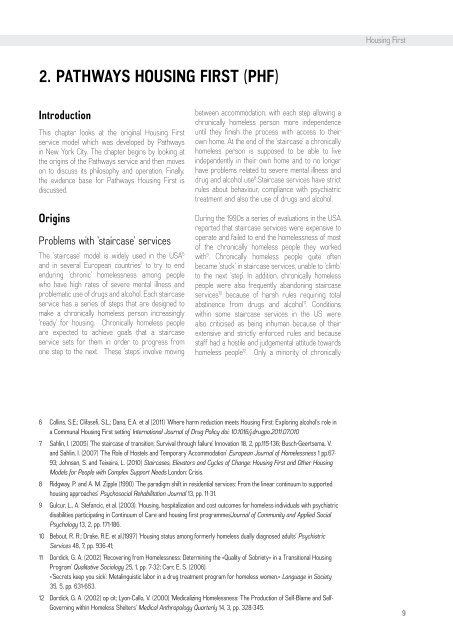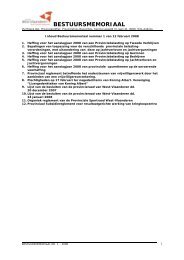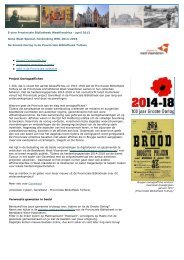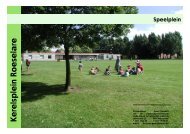Housing First - Provincie West-Vlaanderen
Housing First - Provincie West-Vlaanderen
Housing First - Provincie West-Vlaanderen
Create successful ePaper yourself
Turn your PDF publications into a flip-book with our unique Google optimized e-Paper software.
<strong>Housing</strong> <strong>First</strong>2. Pathways <strong>Housing</strong> <strong>First</strong> (PHF)IntroductionThis chapter looks at the original <strong>Housing</strong> <strong>First</strong>service model which was developed by Pathwaysin New York City. The chapter begins by looking atthe origins of the Pathways service and then moveson to discuss its philosophy and operation. Finally,the evidence base for Pathways <strong>Housing</strong> <strong>First</strong> isdiscussed.OriginsProblems with ‘staircase’ servicesThe ‘staircase’ model is widely used in the USA 6and in several European countries 7 to try to endenduring ‘chronic’ homelessness among peoplewho have high rates of severe mental illness andproblematic use of drugs and alcohol. Each staircaseservice has a series of steps that are designed tomake a chronically homeless person increasingly‘ready’ for housing. Chronically homeless peopleare expected to achieve goals that a staircaseservice sets for them in order to progress fromone step to the next. These ‘steps’ involve movingbetween accommodation, with each step allowing achronically homeless person more independenceuntil they finish the process with access to theirown home. At the end of the ‘staircase’ a chronicallyhomeless person is supposed to be able to liveindependently in their own home and to no longerhave problems related to severe mental illness anddrug and alcohol use 8 .Staircase services have strictrules about behaviour, compliance with psychiatrictreatment and also the use of drugs and alcohol.During the 1990s a series of evaluations in the USAreported that staircase services were expensive tooperate and failed to end the homelessness of mostof the chronically homeless people they workedwith 9 . Chronically homeless people quite oftenbecame ‘stuck’ in staircase services, unable to ‘climb’to the next ‘step’. In addition, chronically homelesspeople were also frequently abandoning staircaseservices 10 because of harsh rules requiring totalabstinence from drugs and alcohol 11 . Conditionswithin some staircase services in the US werealso criticised as being inhuman because of theirextensive and strictly enforced rules and becausestaff had a hostile and judgemental attitude towardshomeless people 12 . Only a minority of chronically6 Collins, S.E.; Clifasefi, S.L.; Dana, E.A. et al (2011) ‘Where harm reduction meets <strong>Housing</strong> <strong>First</strong>: Exploring alcohol’s role ina Communal <strong>Housing</strong> <strong>First</strong> setting’ International Journal of Drug Policy doi: 10.1016/j.drugpo.2011.07.0107 Sahlin, I. (2005) ‘The staircase of transition: Survival through failure’ Innovation 18, 2, pp.115-136; Busch-Geertsema, V.and Sahlin, I. (2007) ‘The Role of Hostels and Temporary Accommodation’ European Journal of Homelessness 1 pp.67-93; Johnsen, S. and Teixeira, L. (2010) Staircases, Elevators and Cycles of Change: <strong>Housing</strong> <strong>First</strong> and Other <strong>Housing</strong>Models for People with Complex Support Needs London: Crisis.8 Ridgway, P. and A. M. Zipple (1990) ‘The paradigm shift in residential services: From the linear continuum to supportedhousing approaches’ Psychosocial Rehabilitation Journal 13, pp. 11-31.9 Gulcur, L., A. Stefancic, et al. (2003). ‘<strong>Housing</strong>, hospitalization and cost outcomes for homeless individuals with psychiatricdisabilities participating in Continuum of Care and housing first programmes’Journal of Community and Applied SocialPsychology 13, 2, pp. 171-186.10 Bebout, R. R.; Drake, R.E. et al.(1997) ‘<strong>Housing</strong> status among formerly homeless dually diagnosed adults’ PsychiatricServices 48, 7, pp. 936-41;11 Dordick, G. A. (2002) ‘Recovering from Homelessness: Determining the «Quality of Sobriety» in a Transitional <strong>Housing</strong>Program’ Qualitative Sociology 25, 1, pp. 7-32; Carr, E. S. (2006).«’Secrets keep you sick’: Metalinguistic labor in a drug treatment program for homeless women.» Language in Society35, 5, pp. 631-653.12 Dordick, G. A. (2002) op cit; Lyon-Callo, V. (2000) ‘Medicalizing Homelessness: The Production of Self-Blame and Self-Governing within Homeless Shelters’ Medical Anthropology Quarterly 14, 3, pp. 328-345.9
















